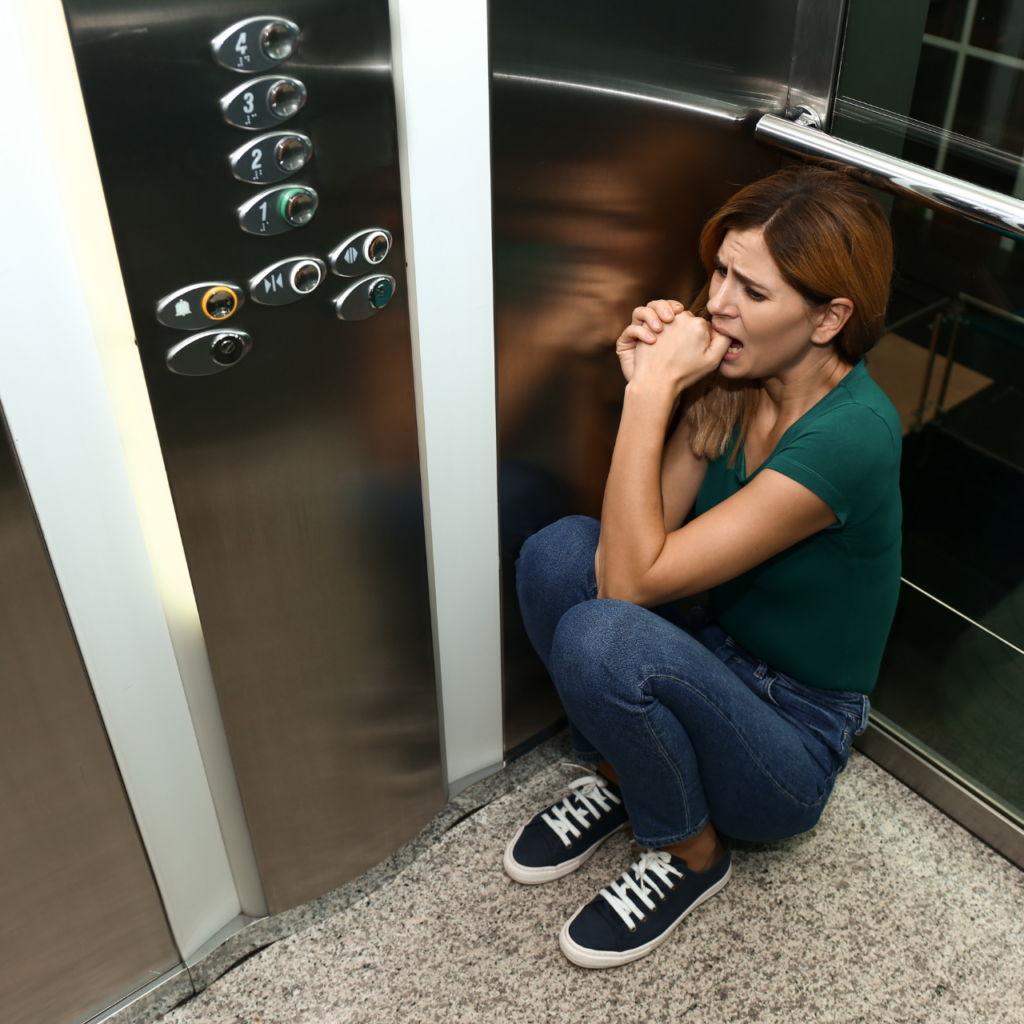
This guide provides information about specific phobias, focusing on common fears related to driving, being a passenger in a car, loud noises, and flying. It explains potential causes, outlines effective treatments like Exposure and Response Prevention (ERP), and guides you through creating and using an exposure ladder to gradually face your fears.
Important Note: This information is for educational purposes and is not a substitute for professional diagnosis or treatment. If you are struggling with a phobia, please consult a qualified mental health professional.
What is a Specific Phobia?
A specific phobia is an intense, persistent, and excessive fear of a particular object, situation, activity, or animal. This fear is disproportionate to the actual danger posed and often leads to avoidance behaviors that can significantly interfere with daily life, work, or relationships.
Common examples include fears of heights, spiders, injections, flying, enclosed spaces, and, as relevant here, specific aspects of driving or being in vehicles.
What Causes Specific Phobias?
The exact cause isn’t always clear, but specific phobias likely develop from a combination of factors:
- Direct Learning Experiences: A traumatic event, like a car accident or severe turbulence during a flight, can trigger a phobia. Witnessing someone else have a negative experience can also contribute.
- Informational Learning: Hearing or reading about dangerous events (e.g., plane crashes, severe car accidents) can sometimes lead to developing a phobia.
- Genetics and Brain Chemistry: Some individuals may have a genetic predisposition to anxiety, making them more susceptible to developing phobias. Brain chemistry and function can also play a role.
- Evolutionary Factors: Some phobias (like fear of snakes or heights) might have evolutionary roots, stemming from dangers faced by our ancestors.
ERP therapy involves exercises that help confront fears head-on while resisting compulsions. However, for some people, intrusive thoughts and anxiety can make it challenging to fully engage in therapy exercises, which is where medication can help.
“Exposures tend to be helpful, as they slowly and gradually introduce patients to their intrusive thoughts and get them to a point where the thoughts aren’t as distressing,” says Maddison Henley, PA-C, Director of Clinical Operations and Clinical Education at Animo Sano Psychiatry. “In the beginning [of therapy], medication can be helpful because it provides baseline support, and ERP is working on top of that to help manage symptoms further.”

Treatments for Specific Phobias
Several effective treatments are available:
- Exposure and Response Prevention (ERP): This is widely considered the gold standard treatment for specific phobias. It involves gradually and repeatedly exposing yourself to the feared object or situation in a safe and controlled way, without engaging in avoidance or safety behaviors.
- Cognitive Behavioral Therapy (CBT): CBT helps identify and challenge negative thought patterns associated with the phobia and teaches coping skills. ERP is often a core component of CBT for phobias.
- Medication: While not typically a first-line treatment for specific phobias on its own, medication (like anti-anxiety drugs or beta-blockers) might sometimes be used short-term to manage intense anxiety during exposure or in specific situations (like before a flight), usually in conjunction with therapy.
Focus: Exposure and Response Prevention (ERP)
What is it?
ERP is based on the principle that avoidance maintains fear. By confronting the feared situation without resorting to escape or safety behaviors (like gripping the steering wheel excessively, constantly checking mirrors, avoiding highways, or refusing to fly), you learn that the feared outcome is unlikely and that your anxiety naturally decreases over time (habituation).

How does it work?
- Exposure: You systematically confront triggers, starting with less anxiety-provoking ones and gradually moving up to more challenging ones.
- Response Prevention: You actively resist the urge to perform compulsive or safety behaviors that temporarily reduce anxiety but reinforce the fear long-term.
Key Principles:
- Gradual: Start small and build confidence.
- Prolonged: Stay in the situation long enough for anxiety to peak and then decrease.
- Repeated: Practice exposures regularly.
- Without Safety Behaviors: Resist urges to “undo” the exposure or make it feel safer artificially.
Developing Your Exposure Ladder (Hierarchy)
An exposure ladder is a list of feared situations ranked from least to most anxiety-provoking. It provides a roadmap for ERP.
Steps to Create Your Ladder:
- Identify Your Fears: Be specific. Instead of “fear of driving,” list specific triggers like “driving on a quiet street,” “driving on the highway,” “driving at night,” “hearing a loud truck horn,” “being a passenger at 65 mph,” “booking a flight,” “boarding a plane.”
- Rate Your Fear: Use the Subjective Units of Distress Scale (SUDS), rating each situation from 0 (no anxiety) to 100 (extreme panic/worst fear imaginable).
- Rank the Situations: Arrange the identified situations in order from lowest SUDS rating to highest. Aim for 10-15 steps, with manageable increases in difficulty between steps (e.g., 5-10 point jumps on the SUDS scale).
- Be Specific: Detail exactly what the exposure involves (e.g., “Sit in the driver’s seat with the engine off for 5 minutes,” “Drive around the block once,” “Listen to a recording of highway noise for 2 minutes,” “Watch videos of planes taking off for 10 minutes”).
Engaging in ERP Using Your Ladder
- Start Low: Begin with the item on your ladder that causes mild anxiety (e.g., SUDS 20-30).
- Plan the Exposure: Decide when, where, and for how long you will do the exposure.
- Commit: Engage in the exposure exercise.
- Focus on the Present: Pay attention to your surroundings and your physical sensations. Notice the anxiety.
- Resist Safety Behaviors: Actively work against urges to escape, distract yourself excessively, or perform rituals.
- Stay Until Anxiety Decreases: Remain in the situation until your SUDS rating drops significantly (ideally by about half). This teaches your brain that the situation is manageable and the anxiety is temporary.
- Repeat: Practice the same exposure step repeatedly until it consistently causes much less anxiety (e.g., SUDS drops below 20).
- Move Up: Once you feel comfortable with one step, move to the next slightly more challenging item on your ladder.
- Be Patient: Progress takes time and consistency. Some steps may take longer than others. Setbacks can happen; just return to the last successful step and try again.
- Self-Compassion: Be kind to yourself throughout the process. Facing fears is challenging work.
Example Exposure Ladders
Here are examples tailored to the phobias mentioned. These are just examples; your own ladder must be personalized.
Example 1: Fear of Driving
| Step | Estimated SUDS (0-100) |
| 1. Sit in the driver’s seat (engine off) for 5 min | 15 |
| 2. Sit in the driver’s seat (engine on) for 5 min | 25 |
| 3. Drive around an empty parking lot for 5 min | 35 |
| 4. Drive down your quiet residential street and back | 45 |
| 5. Drive on familiar local roads (low traffic) for 10 min | 55 |
| 6. Drive on a slightly busier road (35-40 mph) for 10 min | 65 |
| 7. Drive during moderate traffic for 15 min | 75 |
| 8. Drive on a highway entrance ramp, then exit | 80 |
| 9. Drive on the highway for one exit (daytime) | 85 |
| 10. Drive on the highway for several exits (daytime) | 90 |
| 11. Drive on the highway at night | 95 |
Example 2: Fear of Being a Passenger (High Speeds)
| Step | Estimated SUDS (0-100) |
| 1. Sit as passenger in parked car for 5 min | 10 |
| 2. Be driven slowly around a parking lot | 20 |
| 3. Be driven on quiet residential streets (25 mph) for 5 min | 30 |
| 4. Be driven on local roads (35-40 mph) for 10 min | 45 |
| 5. Be driven on a slightly busier road (45 mph) for 10 min | 55 |
| 6. Be driven on a multi-lane road (50-55 mph) for 10 min | 65 |
| 7. Be driven on a highway entrance ramp, then exit immediately | 75 |
| 8. Be driven on the highway for one exit (60-65 mph) | 85 |
| 9. Be driven on the highway for several exits (65-70 mph) | 90 |
| 10. Be driven on the highway during moderate traffic (65-70 mph) | 95 |
Example 3: Fear of Loud Noises in Cars
| Step | Estimated SUDS (0-100) |
| 1. Listen to quiet car engine sounds (recording) for 2 min | 15 |
| 2. Listen to recording of normal traffic sounds for 3 min | 25 |
| 3. Listen to recording including occasional horn honk for 3 min | 35 |
| 4. Listen to recording of loud truck/bus engine sounds for 2 min | 45 |
| 5. Sit in parked car, listen to radio at moderate volume | 50 |
| 6. Sit in parked car with windows slightly open, listen to outside traffic | 55 |
| 7. Be a passenger on quiet road, windows slightly open | 60 |
| 8. Be a passenger on busier road, windows slightly open | 70 |
| 9. Be a passenger on highway, listen for truck noises (windows closed) | 80 |
| 10. Be a passenger on highway, windows slightly open | 90 |
Example 4: Fear of Flying
| Step | Estimated SUDS (0-100) |
| 1. Look at pictures of airplanes online for 5 min | 15 |
| 2. Watch videos of planes taking off/landing (calm weather) for 10 min | 25 |
| 3. Watch videos recorded inside a plane during flight for 10 min | 35 |
| 4. Research flight routes and safety statistics online for 15 min | 40 |
| 5. Drive to the airport and watch planes from afar | 50 |
| 6. Go inside the airport terminal (not past security) for 20 min | 60 |
| 7. Book a very short flight (e.g., 1 hour) | 70 |
| 8. Pack for the flight | 75 |
| 9. Drive to the airport on the day of the flight | 80 |
| 10. Go through security check | 85 |
| 11. Wait at the gate | 90 |
| 12. Board the airplane | 95 |
| 13. Sit in seat during taxi and takeoff | 98 |
| 14. Experience the short flight | 100 |
Blank Exposure Ladder Template
Use this template to create your own personalized ladder(s). You might need separate ladders for different phobias (e.g., one for driving, one for flying).
My Exposure Ladder for:
| Step # | Exposure Situation (Be specific: What, where, how long?) | Estimated SUDS (0-100) | Date Completed | Peak SUDS During | SUDS After | Notes/Response Prevention Focus |
| 1 | ||||||
| 2 | ||||||
| 3 | ||||||
| 4 | ||||||
| 5 | ||||||
| 6 | ||||||
| 7 | ||||||
| 8 | ||||||
| 9 | ||||||
| 10 | ||||||
| 11 | ||||||
| 12 | ||||||
| 13 | ||||||
| 14 | ||||||
| 15 |
(Add more rows as needed)
Remember: Facing fears takes courage and practice. Progress, not perfection, is the goal. Working with a therapist trained in ERP can provide valuable support and guidance through this process.
Manage your OCD with our free downloadable Exposure Ladder template.
Responsibly edited by AI
Other Blog Posts in
Animo Sano Psychiatry is open for patients in North Carolina, Georgia and Tennessee. If you’d like to schedule an appointment, please contact us.
Get Access to Behavioral Health Care
Let’s take your first step towards. Press the button to get started. We’ll be back to you as soon as possible.ecovery, together.





